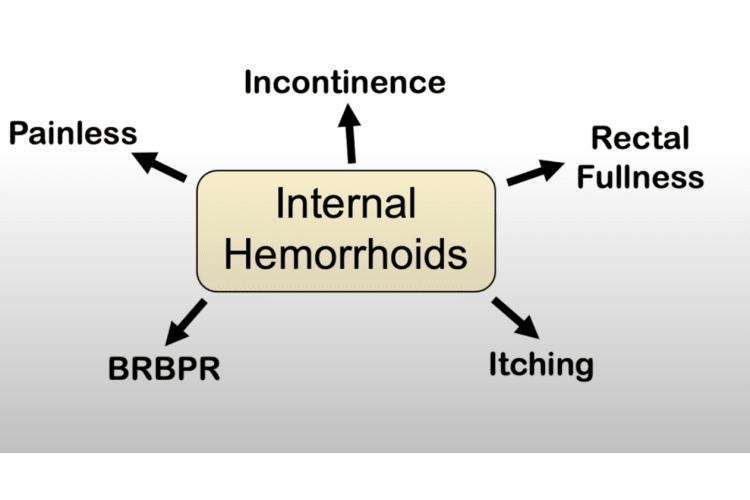Hemorrhoids risk factors and how to avoid them
- Be Healthy
In this blog post, we will talk about the risk factors for getting [[how-did-you-get-rid-of-hemorrhoids-grade-2|hemorrhoids]]. So we’re going to talk about what you can try to avoid in your life to reduce the risk of hemorrhoids and reduce the symptoms of hemorrhoids.
What are hemorrhoids?
Hemorrhoids are vascular cushions or tissues within the anal canal that aid in fecal continence. There is a diagram showing both internal hemorrhoids which are above the dentate line and external hemorrhoids which are below the dentate line.

You don’t really need to know this but this can help with understanding what the difference is between internal and external hemorrhoids.
It’s important to note that everybody has these vascular cushions or tissues but they cause an issue when they become enlarged and become symptomatic. That results in hemorrhoidal disease.
These hemorrhoids are supported by the Treitz’s muscle and because they’re vascular cushions they are filled with blood and they drain through veins.
That blood is drained into the systemic venous system. This will become important in understanding why certain risk factors can lead to issues with hemorrhoidal disease or issues with hemorrhoids.
It’s also important to note that three quarters of adults are affected by hemorrhoidal disease.
Signs and symptoms of hemorrhoids
Before we get into the risk factors for getting hemorrhoids let’s briefly discuss the signs and symptoms of hemorrhoids.
Internal hemorrhoids
Internal hemorrhoids are oftentimes painless they have bright red blood rectum or BRBPR. They are oftentimes itchy patient with internal hemorrhoids often describes a sensation of rectal fullness.
 Patients with internal hemorrhoids can have issues with incontinence.
Patients with internal hemorrhoids can have issues with incontinence.
External hemorrhoids
With external hemorrhoids they are slightly different. Oftentimes there’s a visible mass. You can imagine they are on the outside. They are more visible.
They too can also have itching. There is also external skin tags if there is bleeding with external hemorrhoids. The blood is a darker red and oftentimes they’re painful.
Risk factors for getting hemorrhoids
Let’s talk about the risk factors for getting hemorrhoids and how to reduce risk.
Age
Unfortunately the first risk factor I’m going to talk about is something we can’t change and that is increasing age.
The reason increasing age is a risk factor for getting hemorrhoids is because the Treitz’s muscle becomes less supportive with increasing age.
As I mentioned before the Treitz muscle supports the hemorrhoids and keeps them in place. If there’s an issue with the Treitz muscle and it becomes less supportive an individual can have issues with hemorrhoids.
When I say increasing age I mean over the age of 40. So it’s more likely that individuals over the age of 40 are going to have issues with hemorrhoidal disease.
Low fiber intake
Another risk factor for getting hemorrhoids that we can change is low fiber intake or low fiber diet. The reason is because low fiber intake can lead to chronic constipation.
You can imagine that if you have chronic constipation and you’re straining you are going to have increased intra-abdominal pressure and that is going to lead to pressure on those vascular tissues like those hemorrhoids.
It’s going to enlarge those hemorrhoids and cause issues.
It’s important to increase your fiber consumption and you can do that by eating more lentils. You can choose multi-grain or whole wheat breads, you can eat vegetables like broccoli and peas as well.
Low water fluids intake
Along with low fiber intake low water or fluid intake is also another risk factor for hemorrhoids. This is related to constipation.
This water this fluid intake works along with the fiber. The fiber absorbs the fluid and aids with bowel functioning. It reduces the risk of constipation again. This will reduce the intra-abdominal pressure.
So it’s important to increase your water and fluid consumption. Along with increasing your fiber intake it’s important to increase your water or fluid consumption as well.
Overweight or obesity
Another risk factor for getting hemorrhoids is overweight or obesity.
This is because of more specifically central obesity or having a large abdomen. You can imagine that if you have a large abdomen there’s going to be increased intra-abdominal pressure which means that there is reduced venous return there’s more pressure in the venous system because of this.
And because there’s more pressure in the venous system the blood in those vascular cushions or those hemorrhoids are not going to be able to be drained properly. We’re going to have issues with having blood staying in those hemorrhoids and possibly becoming enlarged.
It’s important to try to lose weight especially losing belly fat.
Trying to lose that central fat is important in reducing the symptoms and the risk of getting hemorrhoids.
Heavy lifting or strenuous exercise
Another receptor for getting hemorrhoids is heavy lifting or strenuous exercise.
The reason is because of straining or utilization of abdominal muscles.
Again, this all has to do with increased intra-abdominal pressure and again reduced venous return. You can see many of these risk factors have a very similar mechanism as to why they cause or worsen hemorrhoids.
It’s important to avoid or reduce strenuous activities that includes heavy lifting strenuous exercising those types of activities. Along with that straining that we mentioned before this can lead into the next risk factor for worsening hemorrhoids or worsening the symptoms of hemorrhoids.
Bad toilet habits
This is what I call toilet habits. With regards to toilet habits straining straining during a bowel movement or straining when urinating in a man who has an enlarged prostate can cause increased pressure in the system.
Another toilet habit that is important to note that can worsen symptoms of hemorrhoidal disease is sitting on the toilet for extended periods of time. This can all increase pressure within those hemorrhoids.
It is important to avoid straining.
Because I mentioned sitting on the toilet for extended periods of time it’s important to avoid reading on the toilet. A lot of patients will sit on the toilet and read but this can worsen symptoms of hemorrhoidal disease.
Some food and beverages
We can also see certain foods and beverages that worsen hemorrhoids or worsen the symptoms of hemorrhoids.
These include low fiber foods we talked about, high fiber intake is important in reducing the risk and reducing the symptoms of hemorrhoids. Any foods with low fiber so if you’re eating a diet full of low fiber foods this can worsen or increase the risk of getting hemorrhoids.
You can think of red meats you can think of white breads and pastries those types of foods.
Caffeine is also an important risk factor. You might be wondering why that? Is so caffeine increases gut motility. This can increase the risk of having diarrhea.
The more often you have bowel movements the more this can irritate those hemorrhoids causing worsening symptoms.
So you want to make sure that you’re not constipated but you want to make sure that you’re not having issues with diarrhea either. That is also important.
Alcohol consumption
Then alcohol consumption is important to avoid or reduce, as alcohol consumption is associated with increased symptoms of hemorrhoidal disease.
Liver disease
Another risk factor for getting hemorrhoids or having hemorrhoidal disease is liver disease.
This is because of portal hypertension. In cirrhosis we can see issues with venous return to the liver.
The liver becomes scarred and the blood flowing through the liver gets slowed down we get increased. Pressures within the portal system and we get increased pressures within the abdominal venous system in general.
Increase inter-abdominal pressure reduced venous return this can lead to hemorrhoidal disease or worsen previous hemorrhoids.
It is important to try to reduce the risk or reduce the progression of liver disease.
So avoiding alcohol intake and in the case of non-alcoholic fatty liver disease it’s important to try to lose weight there’s some other things you can do as well.
Pulmonary disease
Another risk factor for getting hemorrhoids is pulmonary disease.
More specifically chronic obstructive pulmonary disease or copd. The reason being is that it can lead to increased intrathoracic pressure.
Intrathoracic pressure is pressure within your chest.
That increased intrathoracic pressure can result in reduced venous return to the heart leaving more blood in the venous system and more pressure in the venous system and ultimately resulting in increased pressure within those hemorrhoids.
This can worsen hemorrhoidal disease so it’s important to try to again prevent or reduce the risk of getting chronic objective pulmonary disease in the future or if you do have it try to reduce the progression of copd.
It is important to quit smoking so you can try to prevent the progression of copd.
Pregnancy
For completeness sake I want to mention these other risk factors as well. These are something to think about with regards to having hemorrhoidal disease one of them is pregnancy.
Presence of intra-abdominal masses
The other one is intra-abdominal masses so if there’s a space occupying lesion within the abdomen this can also lead to issues with hemorrhoids.
The reason being and many of you have probably already guessed is because of increased intra-abdominal pressure.
Conclusion
Habit changing is crutial to reduce hemorrhoids and limit it’s development.
If you want more information on foods and beverages to avoid, check the related posts linked to this one.
If you have hemorrhoids please check the posts on that topic.








